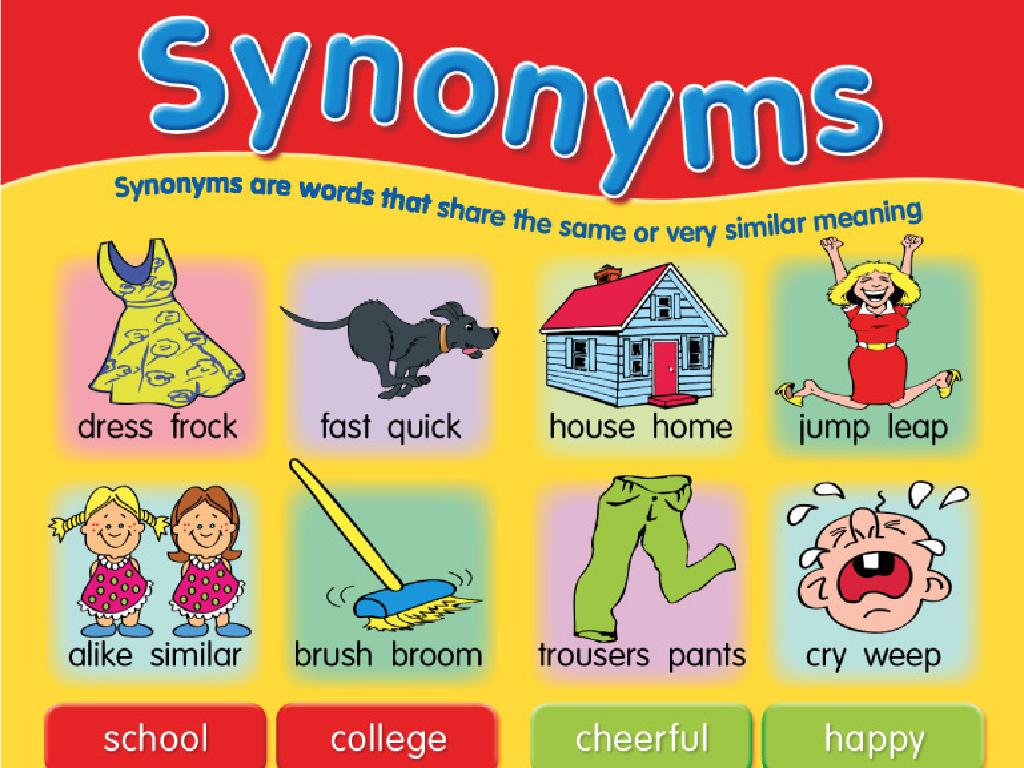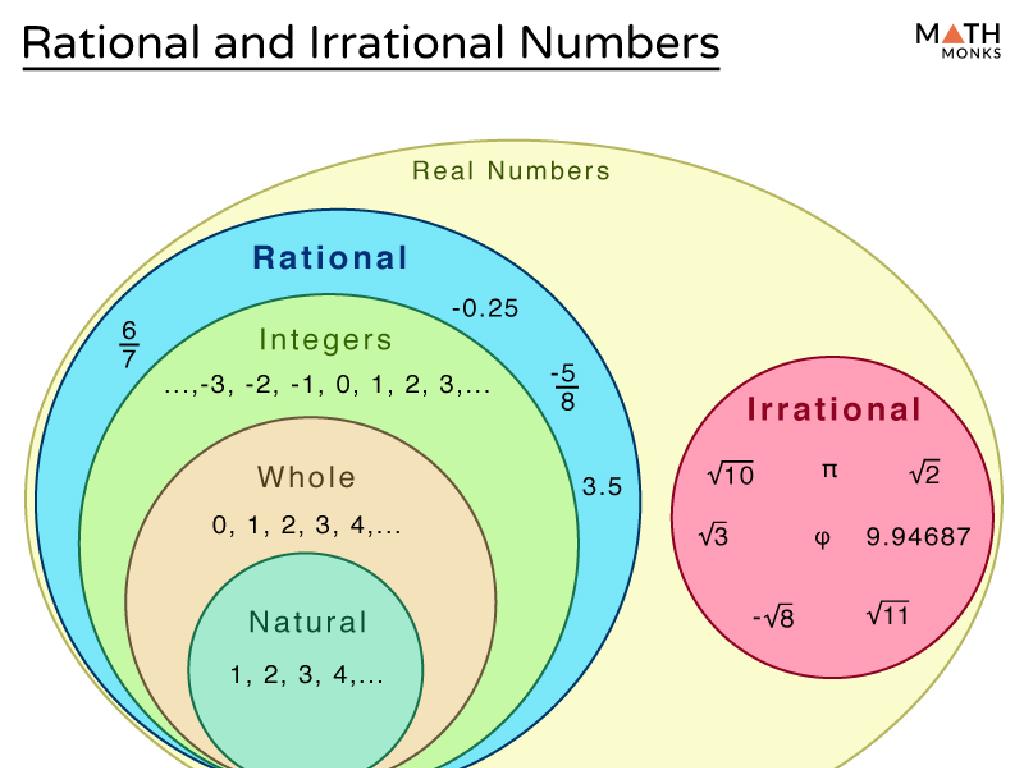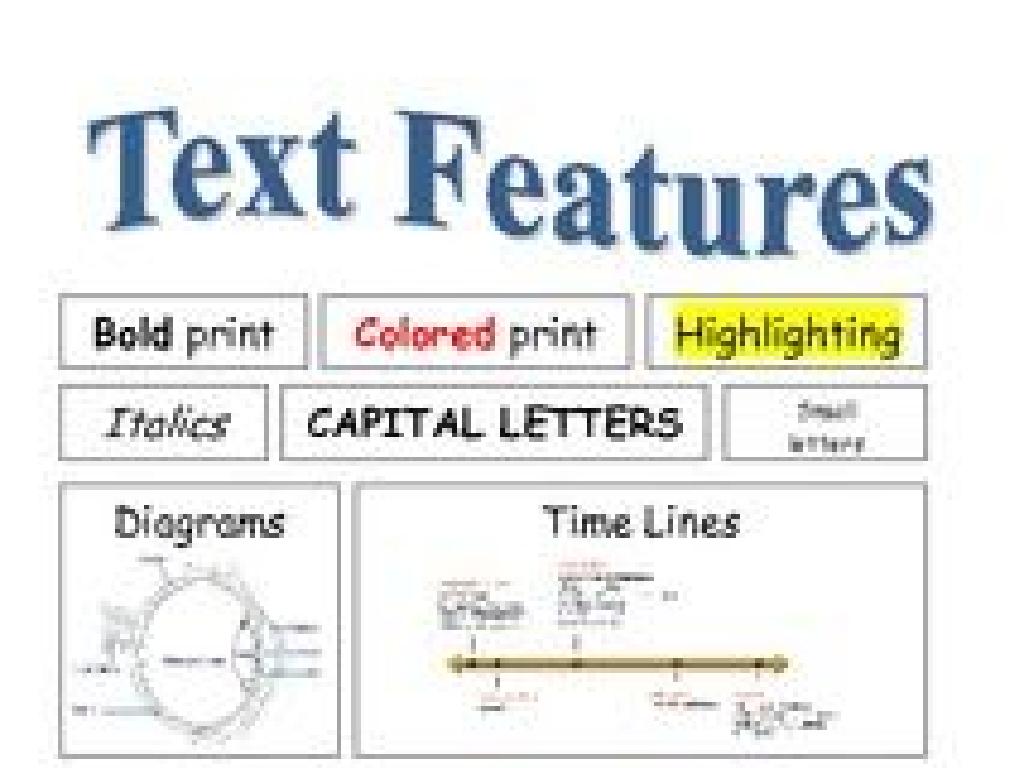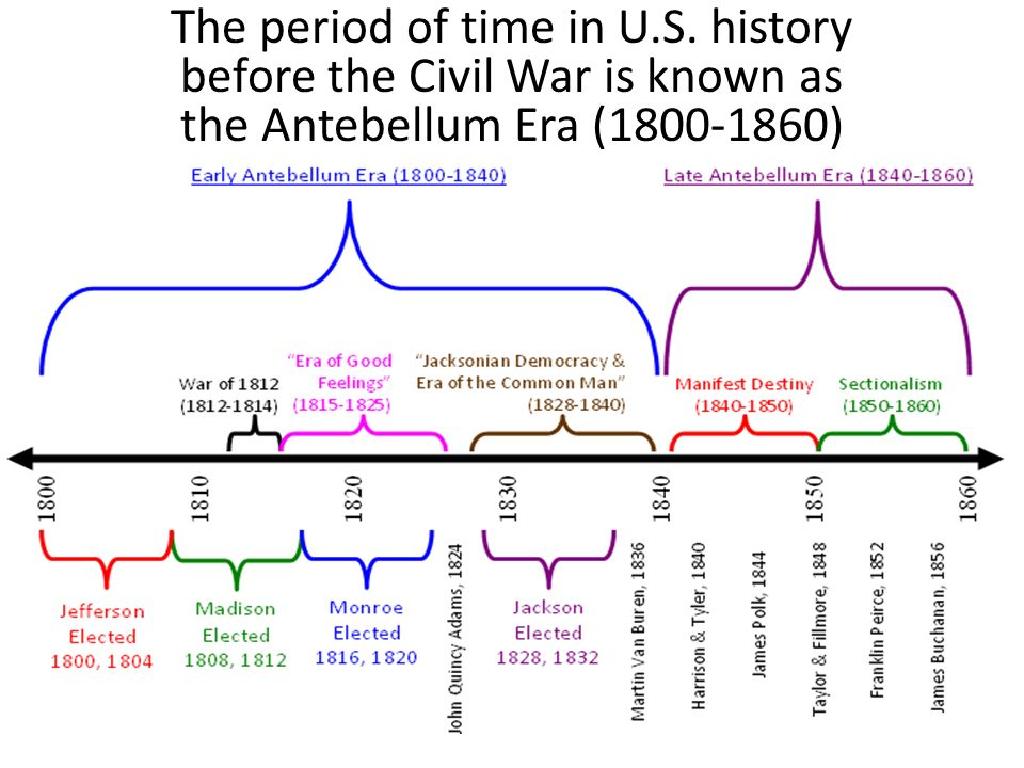Count Pennies, Nickels, Dimes, And Quarters
Subject: Math
Grade: First grade
Topic: Money
Please LOG IN to download the presentation. Access is available to registered users only.
View More Content
Welcome to Money Math!
– Learn about different coins
– Identify pennies, nickels, dimes, quarters
– Pennies are copper, nickels are larger and silver
– Understand each coin’s value
– A penny is 1 cent, nickel is 5, dime is 10, quarter is 25
– Counting coins together
– We’ll practice counting coins with fun activities
|
This slide introduces students to the concept of money, specifically coins. Start by showing real coins or pictures of pennies, nickels, dimes, and quarters. Explain the physical differences and the value of each coin. A penny is worth 1 cent, a nickel is worth 5 cents, a dime is worth 10 cents, and a quarter is worth 25 cents. Use examples like ‘How many pennies make a nickel?’ or ‘How many nickels make a quarter?’ to illustrate the concept. Engage the students with hands-on activities where they can practice counting coins and understanding their values. This will help them to become familiar with using money in real-life situations.
Understanding Money: Coins
– Money is used for purchases
– Coins are forms of money
– Pennies, nickels, dimes, and quarters
– Coins have unique names
– Penny, nickel, dime, quarter
– Each coin has its own value
– 1¢, 5¢, 10¢, 25¢ respectively
|
This slide introduces the concept of money to first graders, focusing on coins. Begin by explaining that money is what we exchange for things we need or want, like toys or food. Highlight that there are different types of money, with coins being one of them. Show real coins or images of pennies, nickels, dimes, and quarters, and discuss the name of each coin. Emphasize the value of each coin, helping students to recognize and remember how much each is worth. Use simple examples to show how different coins can add up to the same value, like how five pennies are the same as one nickel. This foundational knowledge sets the stage for further learning about money management and math skills involving currency.
Meet the Pennies
– A penny is worth 1 cent
– Smallest value U.S. coin
– Copper-colored with Lincoln
– Counting with pennies
– Practice by counting pennies to buy small toys or candy
|
This slide introduces the penny to first graders, emphasizing its value, appearance, and significance. Start by explaining that a penny is the smallest unit of money in the U.S. currency system, worth 1 cent. Show them a penny and point out its copper color and the image of Abraham Lincoln on one side. Explain that even though it’s the smallest value coin, it’s important for understanding how money works. Engage the students by having them practice counting pennies, which can help them grasp the concept of accumulation and basic addition. For example, ask how many pennies they would need to buy a small toy or a piece of candy that costs 5 cents.
Nickels are Neat
– A nickel equals 5 cents
– 5 pennies make up a nickel
– Nickels are bigger than pennies
– Compare size with a penny to see the difference
– Thomas Jefferson is on the nickel
– Recognize the nickel by finding Thomas Jefferson’s face
|
This slide introduces students to the nickel, one of the coins they will encounter when learning about money. Start by explaining the value of a nickel and how it compares to the penny, which they may already be familiar with. Show them a real nickel and a penny for a hands-on comparison. Discuss the size difference and the historical figure featured on the nickel, Thomas Jefferson, to help them easily identify it. Reinforce the concept by having students count by fives to understand how nickels add up in value. You can also introduce a simple activity where students match a number of pennies to the equivalent number of nickels.
Dazzling Dimes
– A dime equals 10 cents
– Smallest coin, more value than some
– Though tiny, it’s worth more than a penny (1 cent) and a nickel (5 cents).
– Franklin D. Roosevelt’s face on it
– Our 32nd president is honored on the dime.
– Practice counting by tens with dimes
– If you have 5 dimes, you have 50 cents! Let’s count together.
|
This slide introduces students to the dime, which is a fundamental part of understanding US currency. Emphasize that the dime, despite being the smallest in size among US coins, holds more value than both the penny and the nickel. Highlight the historical significance by mentioning Franklin D. Roosevelt’s depiction on the dime. Engage the students in an activity where they count by tens using dimes to solidify their understanding of its value. For example, ask them how many dimes make 20 cents, 30 cents, and so on. This will help them grasp the concept of counting and accumulation using dimes.
Quirky Quarters: Learning Coin Values
– A quarter equals 25 cents
– Remember, 4 quarters make a dollar!
– The biggest coin of the day
– It’s bigger than pennies, nickels, and dimes.
– George Washington’s on it
– He was the first U.S. president.
|
This slide introduces students to the quarter, which is a fundamental part of understanding U.S. currency. Emphasize that a quarter is worth 25 cents and that it takes four quarters to make one dollar. Show the students a quarter and point out its size relative to the other coins they’ve learned about. Highlight that George Washington’s face is on the quarter, and he was the first president of the United States. You can bring real quarters for a show and tell or use images to help visual learners. Encourage the students to share any quarters they have and discuss their features. This will help them to recognize and value the quarter when they see it in real life.
Counting Coins Together
– Coins make up our money
– Counting coins can be fun
– Let’s count with an example
– Example: If you have 1 dime and 3 pennies, how much do you have?
– 1 nickel + 2 pennies = 7 cents
– A nickel is worth 5 cents, and each penny is worth 1 cent
|
This slide is aimed at helping first graders understand the concept of counting coins to make different amounts of money. Start by explaining that money is made up of coins and that each coin has a different value. Emphasize that counting coins is not only important but can also be enjoyable. Use the example provided to show how different coins add up to make 7 cents. Encourage the students to participate by asking them to count out loud with you. You can also bring in real or play coins for a hands-on activity to reinforce the concept. Make sure to explain the value of each coin: a penny is 1 cent, a nickel is 5 cents, a dime is 10 cents, and a quarter is 25 cents. This will prepare them for the activity and help them understand how to combine different coins to form specific amounts.
Money Math Activity: Playing Storekeeper
– Engage in ‘Storekeeper’ game
– Use play coins for transactions
– Pretend coins represent real money
– Count coins for items
– How many pennies equal a nickel? Let’s find out!
– Practice makes perfect!
|
This interactive activity is designed to help first graders understand the value of different coins and practice counting money. Set up a ‘store’ in the classroom with various items labeled with prices. Provide students with play coins and have them ‘purchase’ items by counting out the correct amount of money. This hands-on experience reinforces their ability to recognize coins and understand their values. Encourage them to use different combinations of pennies, nickels, dimes, and quarters to reach the total amount. Observe and assist students as needed, and consider having them take turns being the storekeeper to involve addition and subtraction skills. Prepare a variety of items and prices to cater to different skill levels within the class.
Review and Goodbye: Coin Recap
– Review coin values
– Pennies = 1 cent, Nickels = 5 cents, Dimes = 10 cents, Quarters = 25 cents
– Practice counting coins
– Keep practicing with real coins or drawings
– Praise for today’s effort
– Looking forward to next class
|
As we wrap up today’s lesson on counting coins, it’s important to reinforce the value of each coin: pennies, nickels, dimes, and quarters. Encourage the students to continue practicing at home with real coins or by drawing them. Acknowledge the hard work they’ve put into learning today and express excitement for the next class. Remind them that practice is key to becoming confident in counting money. Prepare a few simple worksheets or interactive games for the next class to further solidify their understanding.






